Orville Gibson
| Orville Gibson | |
|---|---|
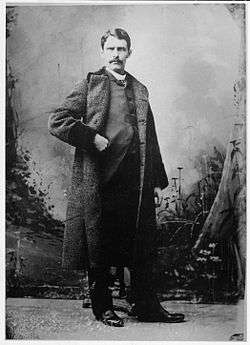 Orville Gibson (pre 1910) | |
| Born |
Orville H. Gibson Chateaugay, New York, United States |
| Died |
August 19, 1918 Ogdensburg, New York, United States |
| Occupation | Inventor and company founder |
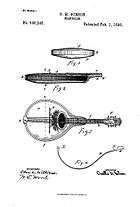
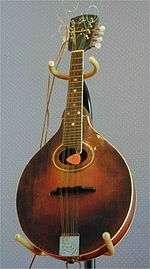
Orville H. Gibson (May 1856 – August 19, 1918) was a luthier who founded the Gibson Guitar Company in Kalamazoo, Michigan in 1902, makers of guitars, mandolins and other instruments.[2] His earliest known instrument was a 10-string mandolin-guitar, which bears the date 1894.[3] His mandolins were "unlike any previous flatback instrument," according to music historian Paul Sparks. His company's manufacturing standards were very high, and his instruments heavily marketed. He and his company used music teachers to market the instruments, and strong print advertisements to displace the round-backed mandolins. They were successful in the mandolin market, eliminating the production of round-backed instruments in America.[4] His guitars were influential as well, and his guitar patterns are still recognizable in modern jazz guitars.[3]
According to George Gruhn, the idea of carving the instrument tops and bottoms appears to have originated with Gibson and is not based on any mandolin or guitar building tradition. Although inspired by the carving of violins, he did not use violin manufacturing techniques or patterns to build his instruments.[3]
His company, with the help of instrument designer and sound engineer Lloyd Loar produced the Gibson F-5 mandolin, which Sparks said was acknowledged "to be the finest flat-back mandolin ever produced."[5][6] Loar also designed the L-5 guitar. Among the changes that Loar introduced was the f-hole instead of a round or oval sound-hole, another violin-family feature imported to the mandolin.[4]The mandolins are treasured by bluegrass musicians, but produce opposite feelings of admiration or contempt among the classical musicians they were designed for.[4][5][7] The L-5 guitar has found a home among jazz musicians.
Gibson was born in Chateaugay, New York. According to the 1900 U.S. Federal Census, he was born in May, and his obituary published in The Malone Farmer on Wednesday, August 21, 1918, states he died on August 19th and his funeral was held at the home of his brother O. M. Gibson on August 21st.
Career

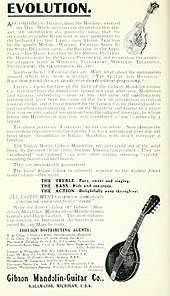
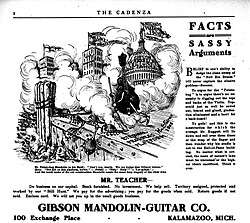
Gibson began in 1894 in his home workshop in Kalamazoo, Michigan and patented his idea for mandolins in 1898.[4] With no formal training, Gibson created an entirely new style of mandolin and guitar that followed violin design, with its curved top and bottom carved into shape, rather than pressed or bent, arched like the top of a violin.[10] He applied for and was granted a patent on the design.[1] The sides too were carved out of a single block of wood, rather than being made of bent wood strips.[4] More importantly, they were louder and more durable than contemporary fretted instruments, and musicians soon demanded more than he was able to build in his one-man shop.
%2C_Gibson_Style_A4_Mandolin_(1915)%2C_Washburn_Parlor_Guitar_(1894)%2C_Museum_of_Making_Music.jpg)
%2C_Maybelle_Carter%2C_CMHF_clip1.jpg)
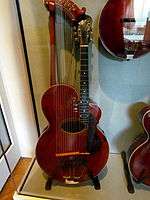
On the strength of Gibson's ideas, five Kalamazoo businessmen formed the Gibson Mandolin-Guitar Mfg. Co., Ltd., in 1902. Within a short period after the company was started, the board passed a motion that "Orville H. Gibson be paid only for the actual time he works for the Company." After that time, there is no clear indication whether he worked there full-time, or as a consultant. Julius Bellson states in his 1973 publication, The Gibson Story, that "Orville Gibson had visions and dreams that were considered eccentric."
Illness and death
Starting in 1908, Gibson was paid a salary of $500 by Gibson Mandolin-Guitar Manufacturing Co., Limited (equivalent to $20,000 a year in modern terms). He had a number of stays in hospitals between 1907 and 1911. In 1916, he was again hospitalized, and died on August 19, 1918, at 62 years of age, in St. Lawrence State Hospital in Ogdensburg, New York.[12] Gibson is buried at Morningside Cemetery in Malone, New York.
Notes
- 1 2 US 598245, Gibson, Orville, "Mandolin", published 1895, issued 1898.
- ↑ "Gibson History". Gibson Corporate Press Kit. Gibson Guitar Corp. Archived from the original on 29 April 2012. Retrieved 20 May 2012.
- 1 2 3 Gruhn, George. "Orville Gibson's Last Mandolin". mandolinarchive.com. Retrieved 19 May 2018.
- 1 2 3 4 5 Sparks 2003, p. 129-132
- 1 2 Sparks 2003, p. 155
- ↑ "In Memoriam, Lloyd A. Loar". Fretted Instrument News. Providence, Rhode Island: The Rhode Island Music Company. November–December 1943. Retrieved May 17, 2018.
designer and acoustical engineer
- ↑ Sparks 2003, p. 157
- ↑ Philip J. Bone (1914). The guitar and mandolin, Biographies of celebrated players and composers for these instruments. London: Schott and Company.
- ↑ "Facts are sassy arguements". Cadenza. Boston: Walter Jacobs. September 1908. Retrieved 19 May 2018. To cite an online magazine article that has been archived
- ↑ Gruhn, George (1991). Gruhn's Guide to Vintage Guitars. San Francisco: GPI Books. p. 73. ISBN 978-0-87930-195-8.
- ↑ Alcantara, Paul. "85558- Gibson L-5". prewargibsonl-5.com. Retrieved 20 May 2018.
Joe Span...Spain's Guide to Gibson...I conclude that Maybelle's guitar was shipped in January of 1930.
- ↑ Siminoff, Roger (2007), Orville H. Gibson, 1856–1918, retrieved 2009-03-17
- Chris Gill (1994-09-01). Guitar Player (magazine) (September 1994). Missing or empty
|title=(help) - Sparks, Paul (2003). The Classical Mandolin. Oxford: Oxford University Press. ISBN 9780195173376.